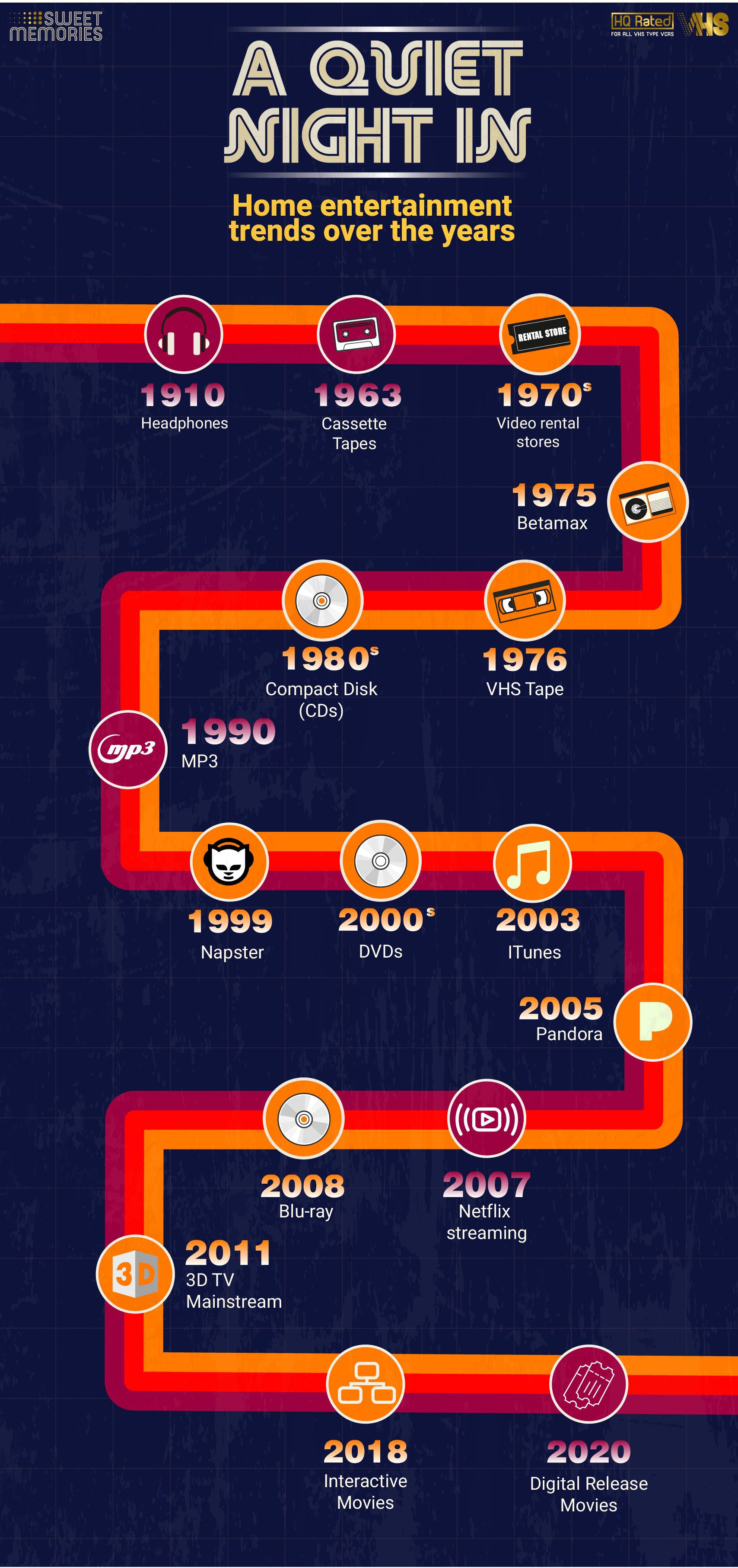The Burrow

As experts in insurance, we know that regardless of whether your home entertainment collection includes all the latest films or some of the more old-school gadgets, home and contents insurance could go a long way to protect your precious devices.
Not only can it provide cover for accidental damage to your items (if you are covered by an appropriate policy), but it can cover the cost of replacing your belongings if they are damaged or lost due to unforeseen circumstances such as a natural disaster, or another event that you are insured for.
To see exactly what you are covered for in any given policy, it’s a good idea to check the Product Disclosure Statement (PDS). This will outline any limits, restrictions and exclusions that you will be subject to in the event you need to make a claim.
If you’re the type of person who truly values your collection of rare, vintage VHS tapes or your original, ‘old-school’ PlayStation device, you may enjoy what we’ve pulled together below – a history of home entertainment trends. We’ll start with anniversaries taking place this year.
In 2020, Blockbuster – once an iconic staple of home entertainment – will celebrate 35 years since the opening of its first store in Dallas, Texas, in 1985.2 No doubt you’re now feeling nostalgia for those Friday afternoons spent running through rows upon rows of video – turned DVD – displays to ring in the weekend.
Now that you’re all misty-eyed for times gone by, we’ll gently remind you that 2020 will also see the 10th anniversary of Blockbuster filing for bankruptcy. This move marked the beginning of its sad descent into obsolescence.3
With the anniversary of the opening – and folding – of the beloved Blockbuster taking place this year in conjunction with all the time we’re now spending at home, we thought it’d be an excellent opportunity to look at some home entertainment trends from the past, present and future.

Remember the inconvenience of having to rewind the VHS before returning it to the rental store by 6pm? Or racing to the new releases section only to find all copies of Armageddon were gone? The stores themselves may be a thing from the past, but the memories still linger.
The road to video rental stores more or less began during the 1970s and 80s, when videocassette recorders (VCRs) became more popular as the cost of movie tickets was rising.4
While demand increased for cheaper nights in comparison to nights spent at the cinema, the cost of buying a videocassette (as studios began to rerelease their old movies on VCR to cater to the trend of in-home entertainment) was still too high for a lot of people.
As early as 1985 – when Blockbuster entered the video rental scene – the video rental industry was already earning a revenue of more than three billion dollars!4 And, when DVDs were introduced to home entertainment in the late 1990s, video rental stores dutifully kept up with the times, adding the shiny new discs to their collections.
Alas, the golden age of video rental stores was not to last.
Though video renting hasn’t disappeared entirely (some streaming platforms offer this service, and rental kiosks are kicking around now instead), you’ll be hard-pressed to find a physical video rental store today.
The lack of brick-and-mortar video stores is mainly due to video on demand (VOD) becoming increasingly popular throughout the 2000s. Netflix was already leaving the video rental industry in the dust with its rent-by-mail DVD service, and the launch of its streaming service in the mid-2000s could be argued as the final nail in the coffin.5
So now that people could download a movie directly to their computer in the comfort of their own homes, why did they need to go all the way to a store to get the physical copy of a movie they could access in just a few minutes from the likes of Netflix?
The answer is: they didn’t. So, the humble video rental store was all but doomed to remain in the past.

Home audio is probably one of the oldest trends in home entertainment; after all, the ability to listen to music in your own home was more or less created way back in 1857 with the invention of the phonautograph, the first device capable of recording sound.
The next few decades heralded all kinds of inventions and advancements in the field of audio, including:6
Now we’re up to 1963 and the next major development in home audio: the cassette tape, smaller but with better sound quality than its predecessors.6 This beloved development in home audio was followed by the Sony Walkman in 1980, which enabled you to listen to your cassettes anytime and anywhere!
It wasn’t long, however, before yet another audio format was developed, starting yet another format war. The shiny, new compact disc (CD) was convenient and again offer better sound quality than those that came before it, and so naturally it won over home audio.6 Eventually, no home stereo or car was complete without a CD wallet to hold all your favourite albums so you could flick through them with ease.

Home audio took a big leap in the 1990s when MP3 burst onto the scene, enabling audio of CD-quality to be compressed and stored into tiny, handheld players.6 Apple’s iPod soon became the standout amongst MP3 players.
But, soon enough, listening to music began to shift to online. In 1999, music sharing website Napster (where you could share MP3 files with others freely) was taking off in the USA.7 Its wild popularity was short-lived, though, as the website was hit with copyright lawsuits and forced to shut down in 2001 – by which time it had gained more than 20 million users!
Clearly, music streaming was going to be the next big thing.
In 2003, Apple iTunes was launched, and it was followed in 2005 by Pandora, which opened the door for future streaming platforms like Spotify with its ability to identify new music for a user based on their listening history.7
Nowadays, home audio seems to be almost completely dominated by music streaming. By the end of 2019, Spotify alone had reached around 124 million subscribers worldwide.8

You could argue that home video is one of, if not the most important trend in home entertainment. What could be more integral to the concept of home entertainment than sitting down to watch a movie or tv show in your own home whenever you want?
One of the more notable advancements in home video came when Sony introduced the Betamax videotape in 1975.9 (It just so happens to be the 45th anniversary of the release of Betamax this year, too, in case you weren’t already feeling old when we talked about Blockbuster!)
However, Betamax was quickly followed by JVC’s Video Home System (VHS), which was released in Japan in 1976 and the USA the year after.
It very quickly became a battle between Betamax and VHS, despite both formats being pretty similar to each other. In fact, within the first year of VHS’ release in the USA, it had stolen around 40% of Betamax’s business. By 1987, VHS had taken over 90% of the USA’s VCR sales.9
Ultimately, VHS won this format war and continued to enjoy decades of prosperity and popularity in homes around the world.
However, in the mid-1990s, a new competitor emerged: the Digital Video Disc (DVD). Released in 1997, DVDs offered more storage and better visual and audio quality than VHS, as well as having interactive controls such as menus and special features.10 Higher quality, more storage and with no need to rewind before watching again, DVDs quickly overtook VHS as the preferred format of home video and had almost entirely replaced its predecessor just a few years after they were introduced.
DVDs with a higher definition (HD DVDs) came along not long after and looked to be the next big thing in home video formats since it had the backing of film studios over the new, costlier and unknown Blu-ray.11
However, Blu-ray had the backing of Sony, who built Blu-ray drives into the PlayStation 3, a move that could be argued as the defining moment of Blu-ray and the launchpad of its future success. Now that every gamer with a PS3 also had a Blu-ray drive, the superior HD quality of the discs became more popular and, once cinemas had chosen it over HD DVD, won the latest format war against the Toshiba-backed HD DVD.

One trend that really took home entertainment by storm was the rise of streaming platforms in recent years. No longer would we face the struggle of choosing something to watch from just whatever happened to be on TV at the time!
Media streaming as we know it today largely began in 2007 when Netflix – previously known for their DVD rent-by-mail service – launched their new streaming platform with only a few shows.12
Things came to a head in 2010 when Netflix released streaming apps for both iOS and Android, meaning television was now more portable than ever – and certainly more portable than cable TV.12
As a home entertainment trend itself, cable hadn’t really evolved with the times over its decades of existence in American homes, continuing to deny subscribers the ability to choose which channels and content to bundle into their plan even as streaming companies entered the scene promising this capability to viewers.13
Netflix’s easily-accessible apps combined with the rise of the mobile device and improving internet speeds meant that the streaming juggernaut was just too powerful to stop.12 By 2016, Netflix was already present in 60 countries and were launching into 130 new ones.14
Netflix was not without its competitors, though. Just one year after the launch of Netflix streaming service, Hulu also entered the streaming game.12 Over the years, the likes of Amazon, HBO, Disney and even Apple all jumped on board the streaming wagon and, as of 2019, there were more than 110 streaming platforms around the world!
Just some of those services you can choose from include:

It was a relatively short-lived home entertainment trend, but a trend it was. You could even argue that 3D TVs are now better known for their swift descent into failure than for any benefits they provided while they were in their so-called heyday.
While 3D technology has been around for a long time in cinemas (it’s been around since the 1950s!), its advancement into our homes began around the turn of the previous decade when it was enjoying a resurgence in cinema largely thanks to the blockbuster sci-fi film Avatar.22
At first, 3D TV looked to be the next big thing. By 2011, around 24 million 3D-enabled TVs were being sold around the world; that figure rose to 41 million in 2012.23 In the USA, about 23% of TVs bought in 2013 had 3D capabilities.22
Television broadcasters around the world were also starting to broadcast live sport in 3D, including the:23
As quickly as it all began, 3D television started grinding to halt.
In 2013, broadcasters around the world – including the BBC in the UK and Foxtel in Australia – announced they were dropping 3D. In the USA, the largest broadcaster of 3D sports content, ESPN 3D, was closed down.
The 3D trend is also starting to slow in cinemas, with the number of films released in 3D dropping steadily since 2011.
So, why the sudden death of 3D TVs?
One reason cited by broadcasters when discontinuing their 3D programming was the lack of interest from the general public.23 The annoying, bulky and expensive glasses required to watch a 3D TV also played a role in the declining popularity. As of 2017, LG and Sony (the two major manufacturers of 3D TVs) ended their production of the doomed technology.22

Technology, and thus entertainment, is always evolving and changing. Here are a couple of trends we think you should watch out for in the future of home entertainment.
One new and exciting trend in home entertainment that we could see more of in the coming years is the choose-your-own-adventure style of television and film. This format was first seen in television in 2018 with Netflix’s Black Mirror: Bandersnatch.24
The interactive episode allowed viewers to pick which direction they wanted the story of a video game programmer to go in. The format proved so successful that people were watching Bandersnatch many times over to go through every possible choice.
Netflix is already developing more choose-your-own-adventure stories using the software it built for Bandersnatch,24 so be on the lookout for this home entertainment trend gaining traction in the coming years!
As unlikely as you might think, the COVID-19 pandemic and subsequent lockdown may just kickstart a new trend in home entertainment: the release of new movies (initially intended for cinema) straight to streaming platforms. And it could very well be due to the most unlikely film: Trolls World Tour.
As social distancing restrictions came into practice around the world, Universal Pictures decided to release the movie straight to digital rental.25 The move proved to be a smash-hit success as Trolls World Tour was downloaded five million times in the USA and Canada in its first three weeks of release, and earned $95 million in revenue in the process.26
Whether or not the runaway streaming success of Trolls World Tour will forever change the film industry remains unclear. However, you can’t deny that this is a trend that is surely worth watching in the future.
Video rental stores aren’t the only home entertainment trend celebrating an anniversary this year! Here are some more notable birthdays in home entertainment taking place in 2020.
Invented: 1910
Anniversary: 110th
Headphones as we know them today are largely thanks to Nathanial Baldwin, whose 1910 headphone set was a leap forward in the technology.27 Imagine trying to watch your favourite show while on the train or bus without them!
Invented: 1950
Anniversary: 70th
The first remote control for television was developed by the Zenith Radio Corporation in 1950 and aptly called the ‘Lazy Bone’.28 The remote was connected to the TV set by a trip hazard. Oh, sorry, we meant ‘long, awkward cable’.
Released: 2000
Anniversary: 20th
The 20th anniversary of the release of the PlayStation 2 is worth a mention since it sold more than 150 million units around the world in just over ten years!29
Released: 2010
Anniversary: 10th
Hot off the heels of the immeasurably popular iPhone, Apple released the iPad into the world in 2010.30
Launched: 2015
Anniversary: 5th
Australian’s answer (or more like a little brother) to Netflix, Stan, was launched in January 2015.19

Brought to you by Compare the Market: Making it easier for Australians to search for great deals on Home and Contents Insurance.